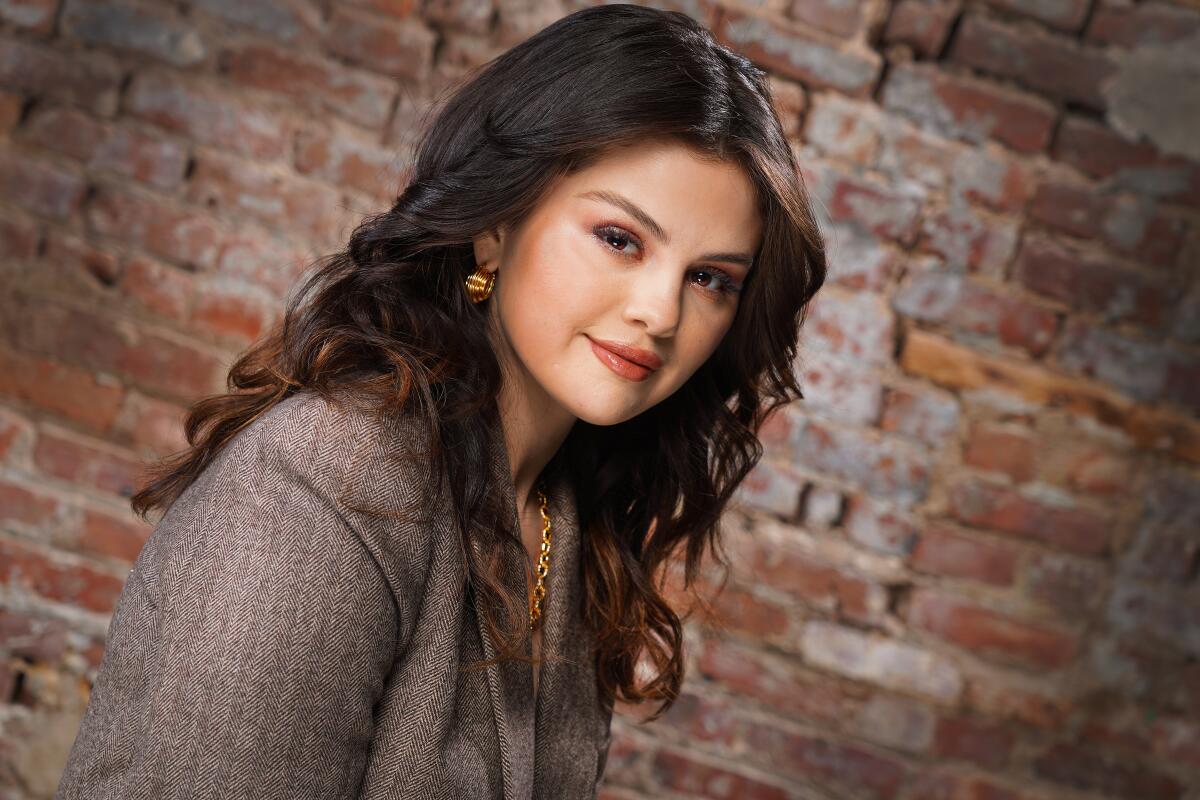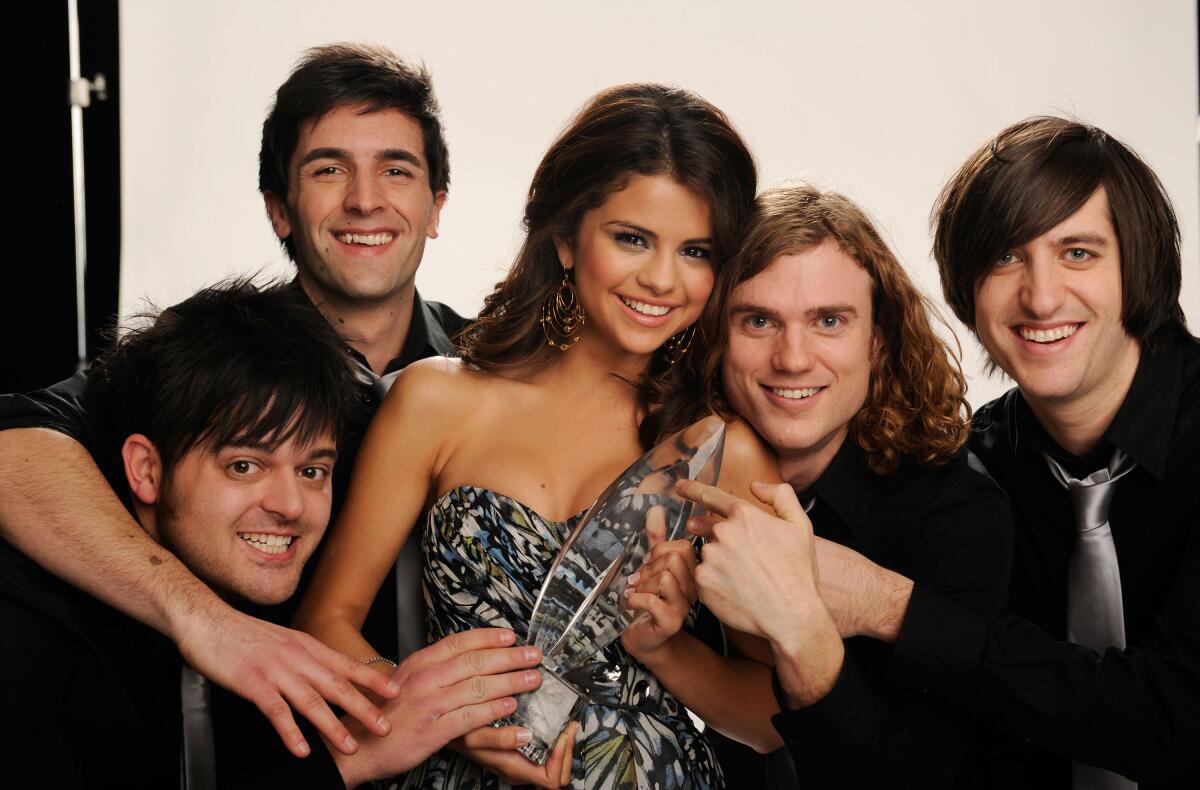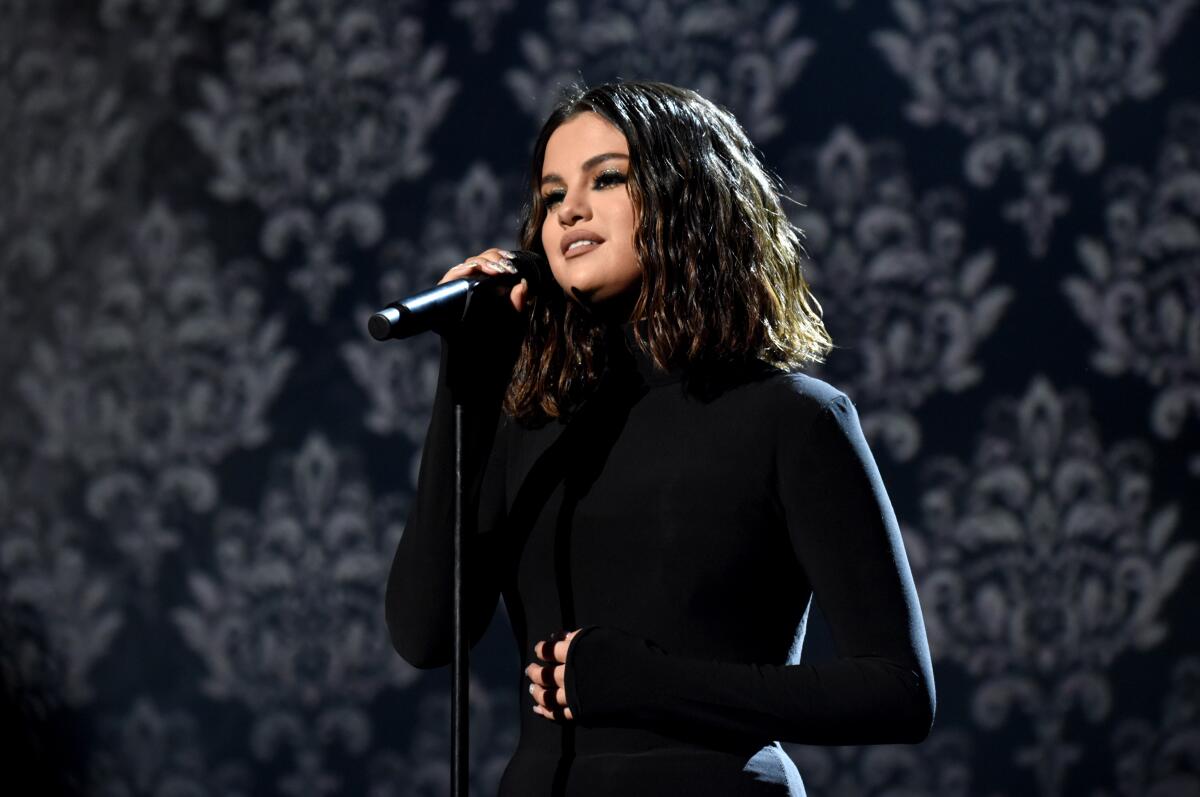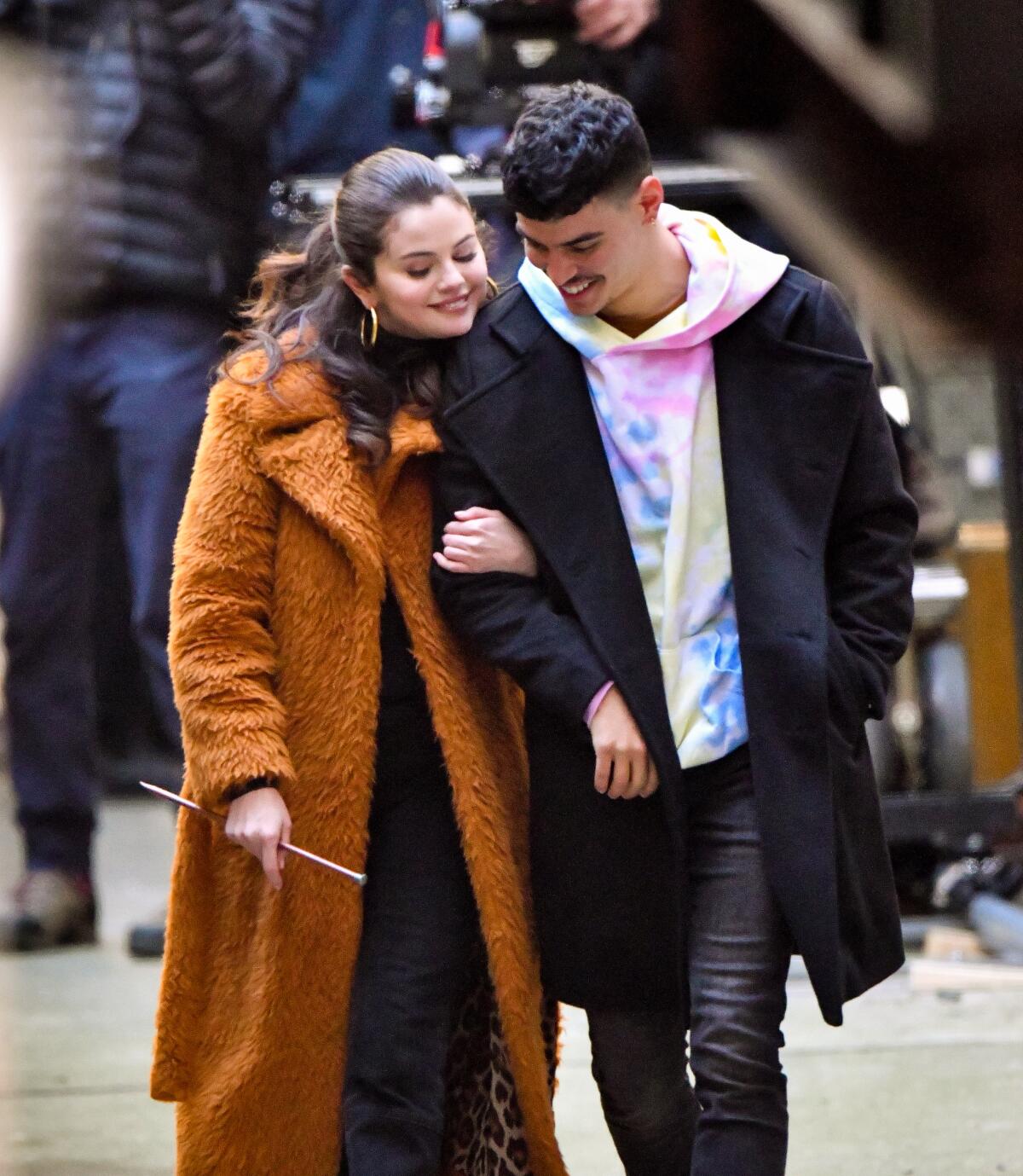How Selena Gomez embraced her Mexican heritage as ‘a source of healing’

- Share via
Selena Gomez is not particularly famous for starting fights — but she’s happy to finish them.
Flanked by cameras and assistants sporting plastic face shields, Gomez has spent the past few weeks walking the streets of Manhattan in a shaggy, rust-colored coat, filming scenes for the Hulu original series “Only Murders in the Building,” a show inspired by true crime podcasts and helmed by comedy greats Steve Martin and Martin Short.
The guys make rather distracting costars for Gomez — “I can barely get through a tape because they’re making me laugh the entire time,” she says — but more distracting are the paparazzi, who, after having a slow year during the COVID-19 pandemic, now trail the 28-year-old superstar doggedly across the city. It was finally on one afternoon in late February when Gomez broke character to throw a middle finger at a cheeky paparazzo on the street. “Somebody was being disrespectful,” she tells The Times. “And I don’t do well with that.”
Our experts forecast wins for Beyoncé’s ‘Black Parade’ and Taylor Swift’s ‘Folklore,’ and that the odds may be stacked against Megan Thee Stallion.
Seated by the window of her New York apartment, Gomez appears via video call in a red flannel button-up shirt and gold hoops, which sharpen the edges of her soft, seraphic profile. “Look, I am a very modest person, until you disrespect people,” she says. “Maybe [it wasn’t] my best moment, but a girl’s gotta do what a girl’s gotta do. And I felt very OK with being like …. ‘Don’t talk to people that way!’”
Gomez has spent the better part of her life taking command over her voice, whether on screen, in song or in her personal life.
The 28-year-old first made her name as a child star of beloved shows like “Barney & Friends” and the Disney Channel series “Wizards of Waverly Place” — then set her kiddie credentials aflame by appearing in Harmony Korine’s 2012 arthouse romp, “Spring Breakers,” cueing her pivot to more PG-13 roles as well as executive producer credits on hot-button shows like “13 Reasons Why.”

Her music career followed the same trajectory in 2012, when she left behind her bubblegum rock band the Scene to cut it as a one-woman act, turning over maximalist dance-floor cuts in 2013’s “Stars Dance” and 2015’s “Revival.” Parting ways with off-and-on flame Justin Bieber, plus a self-imposed mental health sabbatical, helped shape 2020’s “Rare,” her first album in five years and her third consecutive album to debut at No. 1 on the Billboard 200.
Gomez had just begun to celebrate this milestone when, not two months after her album release, the pandemic drove the whole world indoors for the majority of 2020. Quarantine was a familiar experience for Gomez, who spent years in and out of treatment centers for anxiety and depression; in 2015 she was diagnosed with lupus, a long-term autoimmune disease, that forced her to both undergo chemotherapy and obtain a kidney transplant in 2017. Though now in remission, Gomez duly took refuge in her Los Angeles home, where she hunkered down with her grandparents and best friends for months. As the pandemic wound on, Gomez turned her house into a makeshift office space for her cosmetics line, Rare Beauty; a television set for her HBO Max cooking show, “Selena + Chef,” and a recording studio for her first-ever Spanish-language EP, “Revelación,” or “Revelation,” due out March 12.
“The Spanish record wouldn’t have happened had I just kept going with the pace of my life and all my other commitments,” she explains. “A few years ago I would have never had taken these opportunities because of my insecurities or things that I was dealing with mentally. It helped me change my outlook — being able to say ‘If it doesn’t happen right now, that’s OK. That just means it’ll be later or whenever.’”
“It’s nice to be in a place where I feel lucky and grounded and really happy to just be working,” she says.

On “Rare,” Gomez delivered soul-baring pop confessionals like “Lose You to Love Me,” singing self-possessed verses with the reverent lilt of a choirgirl. But on “Revelación,” Gomez evolves into a sensuous tropical siren, swaying both her body and voice to match the rhythm of the ocean tides. Wearing a sumptuous floral gown, and a sacred heart radiating from her chest, Gomez debuted her video for the reggaeton-flavored guitar ballad, “De Una Vez,” in February — building on the same intimate triumphs of “Rare” but for a Spanish-speaking audience.
“Sé que el tiempo a tu lado cortó mis alas / Pero ahora este pecho es antibalas,” she sings, walking her buoyant melody along with the unhurried rhythm of dembow. “I know the time by your side cut my wings / But now this chest is bulletproof.”
It’s an intriguing career pivot for Gomez, who was born and raised in a town called Grand Prairie, on the outskirts of Dallas. Her father, Ricardo Joel Gomez, and her mother, Mandy Teefey, were teenage lovers who went their separate ways when she was 5. Gomez stayed with her mom, an Anglo-American of Italian descent, yet Gomez retained a connection to her Mexican heritage by sharing weekends, holidays and quinceañeras with her father, whose parents first migrated to Texas from Monterrey, Mexico, during the 1970s. “It took 17 years for my grandparents to get citizenship,” says Gomez.
Despite picking up Spanish from her Mexican side of the family, Gomez rarely recorded original songs in the language. Whether featuring on DJ Snake’s 2018 club smash with Ozuna and Cardi B, “Taki Taki,” or opposite J Balvin in 2019 on Tainy and Benny Blanco’s “I Can’t Get Enough,” Gomez deferred most of the Spanish-language lyrics to her Latinx costars.

“I didn’t think I was ready to make a record in Spanish,” she professes. “I was fluent in Spanish until I started working at 7. Then my job just kinda took over my life.”
It was when producing “Living Undocumented,” a 2019 Netflix docuseries that shadows eight immigrant families living in the United States — not to mention hearing the harmful, anti-immigrant rhetoric that circulated during the 2020 presidential election — that Gomez started to see her waning Spanish fluency not as a barrier but as an opportunity for connection. “Maybe embracing that part of me can be a source of healing for somebody else,” she says.
A textured blend of American R&B, electro-pop and reggaeton, “Revelación” features her second collaboration with DJ Snake as well as duets with up-and-coming Puerto Rican MCs Myke Towers and Rauw Alejandro. The six-song EP was overseen by Tainy, the Grammy-nominated producer behind hits by Bad Bunny, J Balvin and most recently Dua Lipa. A native of Puerto Rico and lifelong scholar of reggaeton, Tainy has fashioned his own eclectic take on the island’s homegrown sound — which has not only been absorbed by Latin pop at large but has flourished on the U.S. Billboard charts, extending its shelf life well past the mania surrounding Daddy Yankee and Luis Fonsi’s 2017 crossover success, “Despacito.”
“The Latin community is so versatile,” says Tainy, who collaborated with Gomez over a series of video calls from his studio in Miami. “We’re all from different places, but we inspire each other. Selena can be very humble, but she knows the culture, she knows the sound and she has the range.”

Wary of being the Chicana interloper in a predominantly Caribbean genre, Gomez wanted to connect with her Hispanic fans through the music they love but remain sensitive to the cultural distinctions between Latinos. Prior to recording “Revelación,” she hired Spanish-language coach Leyla Hoyle-Guerrero — who also counts Demi Lovato and Gwen Stefani as clientele — to help freshen her Spanish vocabulary and loosen her accent to better roll with the music.
“There’s a lot of slang that I needed to learn,” says Gomez of the coaching sessions, which became a crash course on unlearning the formal, dated Spanish of her elders. “Spanish changes generationally as well as [geographically]. Sometimes I was like, ‘Wait! Hang on! I need to understand!’
“There would be moments where I would end the [recording] session because I would get so frustrated,” Gomez admits. “Not just trying to create an album from my basement ... but making it sound authentic. That’s something that requires meticulous care. But now, I think I actually sound better in Spanish than I do in English.”

Gomez’s namesake, the late Tejana pop queen Selena Quintanilla-Pérez, suffered a similar identity crisis for years before her untimely death at 23. Though long derided by both Anglos and Mexicans south of the border, Quintanilla-Pérez, who spoke with a Texan twang and notoriously fumbled through her own interviews in Spanish, worked to legitimize the hybrid sound of Tejano music, as both a Latin and North American folk tradition. Gomez has always felt the magnitude of the elder Selena’s legacy, especially as a relative newcomer in the Latin pop space. “It’s an honor to carry her name,” says Gomez.
Selena died when Gomez was two, but, she explains, “her spirit never left my family.” Gomez recalls multiple trips to the Selena memorial in Corpus Christi and met the Quintanilla family before singing “Bidi Bidi Bom Bom” live at the Houston Rodeo in 2010. But her fondest Selena memory by far was when she and her grandmother made a kid-friendly replica of the star’s famous bedazzled bustier. “I used to have this bathing suit,” says Gomez. “My grandmother helped me dye it black and we glued a ton of sequins to the top. I wore it with my jeans, then we found a hat and earrings to dress it up. That’s just what little girls in Texas do.”
As soon as it’s safe again, Gomez has set her sights on South America for her first post-pandemic tour. It’s a bucket list item for the star, who previously canceled the Latin American leg of her “Revival” tour in 2016, citing depression and exhaustion caused by lupus. “South America’s where I would start, because we missed it last time, and because that’s where my heart is,” she says.

Gomez has long grown bored by the ceaseless gossip surrounding her every celebrity interaction and as a result, leaves all social media for her team to manage these days. But after a quiet year, dating rumors were sparked online once again when Gomez was photographed arm in arm with her “Murders” costar Aaron Dominguez. They were filming a scene, she says; but the photos, however innocuous, stirred members of her ride-or-die fanbase dubbed the Selenators. The fans barraged Dominguez’s Instagram account with hostile posts, some of which he highlighted for laughs on his page. “Boy stay the f— away from Selena!” read one message.
“We had just started working together,” she says of Dominguez, shaking her head. “I honestly thought, ‘No wonder guys don’t want to date me!’ I think people only care because I’m young, and the older I get the less they’ll care. For now it’s a part of the job that I don’t really like. I’m actually grateful that I’m not involved with anyone right now.”
Dua Lipa is nominated for six Grammy Awards, second only to Beyoncé. But unlike the music of many of her chart peers, her songs resist a closely personal read.
One can’t help but think of Britney Spears, whose lifetime of overexposure, not to mention her ongoing legal battle for autonomy, recently came up for review in the documentary, “Framing Britney Spears.” Spears was the first artist Gomez saw live in concert; Gomez’s rhythmic vocal flourishes can be traced back to Spears, who in turn, enjoys dancing to Gomez’s songs on Instagram. Out of solidarity for Spears, Gomez declined to watch the documentary.
“I’ve seen so much, and it feels violating for me to watch something like that,” says Gomez. “I couldn’t even imagine. I have nothing but sympathy for her, and I’m happy as long as she is healthy and happy.”
If there is anything to be decoded from Gomez’s “Revelación,” beyond the lyrics themselves, it’s that defining the contours of her identity — apart from a job title, a relationship or a birthplace — will be a lifelong journey and only for her to steer. Once the scene is wrapped, the sun goes down and the relentless pinging of her phone subsides, Gomez can exhale and take comfort in knowing at least she’s the one behind the wheel.
“I don’t have all the answers. There’s no moment when I’m like, ‘OK, guys, I’m healed from everything!’” she says. “It’ll always be a roller coaster. I’m just figuring out what track I want to be on.”
More to Read
The biggest entertainment stories
Get our big stories about Hollywood, film, television, music, arts, culture and more right in your inbox as soon as they publish.
You may occasionally receive promotional content from the Los Angeles Times.












